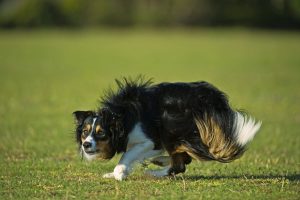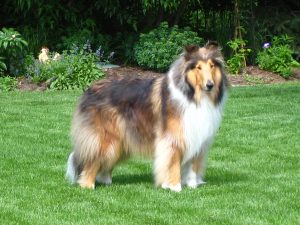Everyone who adopts a puppy will eventually have to leave their precious little bundle of joyful fur and frolic home alone. Work, shopping, errands, children’s activities or even a social outing will at some point separate us from home and hound. Preparing puppies to be calm, and feel safe and secure when you leave is one of the most important lessons you can teach.
Leaving a puppy alone without preparation, and just “hoping for the best” can leave your puppy in a panic. Puppies, dogs, are social creatures. They seek companionship for comfort, and for security. Learning that they are safe when left home alone should start before you actually have to leave your puppy. Every puppy is an individual, so training your puppy to be home alone should be approached with this in mind. Some puppies might breeze through Home Alone training without merely a notice that their people are gone, and others might need a slower and more systematic approach to the training. Either way, remember these two things:
1. The goal is to teach your puppy to calm, and feel safe when you leave.
2. Puppies are new to this world and everything in this world is new to them. Most puppies started their lives with a bunch of siblings to snuggle up to, feel warm with and find comfort in hearing each other’s breathing and heart beats. In the beginning they slept with their Mom nearby. Being swooped up by a stranger and taken to a new home, without their familiar siblings and people (breeder) is stressful enough. Being left in a new home all alone can be outright scary and tramatizing!
There is a lot you can do to teach your dog that being home alone is not so scary. Approach alone time systematically and only build on the duration of time alone as your puppy feels comfortable, secure and safe.
Where should you leave your puppy?
- Teach your puppy Self-Relaxation Protocol (We discussed this in last week’s blog post).
- Establish a safe and comfortable place for your puppy to be when you will not be home. This can be in a safe and secure dog crate/kennel, a stable exercises pen, or safely partitioned into an area of your home where your puppy can get hurt, or cause damage to your home. Make this a warm and comfortable area. The area you choose should be calm and quiet so your puppy is not alerted by noises or visual distractions that might excite or scare them.
- Leaving music on. Slow and relaxing classical music has been shown to have a calming effect on puppies. A company called I-Calm Dog produces music that has been designed to have a calming effect on puppies.
- Leave a towel, t-shirt, or other soft item that you have handled and rubbed your scent on. Snuggling up to something that smells like you can have a calming effect for your puppy.
- Have some activity toys available for your puppy to play with. A favorite stuffed toy, a safe chew toy and a food puzzle toy are all good pacifiers that help your puppy feel relaxed.
- Get your dog comfortable with being in this safe area. You can start by feeding your puppy their meals in this area, giving them special treats as they are calm when in this area. (See last week’s bog post, “Who’s in Control? Teaching Self-Relaxation Protocol”). Offer your puppy a fun interactive food or chew toy when in this area.
- Once your dog has realized that this is a safe and comfortable area you can start to put them in there for short periods at first. Stay close, so your puppy does not feel abandoned and become frightened. You can reinforce your puppy for calm and settled behavior by calmly praising, giving a special treat or calmly petting. Do this intermittently and then less and less as your puppy needs to learn to be calm as you are not present.
- As you puppy has learned to be calm in this safe area you can start to gradually increase your distance and time away from your puppy. Start by just sitting on the other side of the room, then walking into an adjoining room and coming back. Gradually you can teach your puppy to remain calm, self-controlled and self-secure with greater time and distance away from you.
- Once you are sure that your puppy will remain calm and relaxed in their safe place you can start to leave the house. It is best to start with short outings such as going to the mail box or taking out the garbage. You can steadily increase to leaving to go to the store, and eventually back to work.
NOTE: Young puppies may not be able to hold their bowels and bladder as you are away for an eight hour work day. If you work close you may consider going home during your lunch break to let your puppy out to potty. If you have a trusted neighbor who is home during the day you might ask them to check in on your puppy at half way through your absence. Of course, you can always hire a dog walker/sitter to come in and spend some time with your puppy too.
What should you do before putting your puppy in their safe, home alone, area and leave?
- Exercise your puppy for about 30 minutes before you put them into their safe area. Play and exercise will help them to wear off energy and give them the opportunity to go potty before you leave. A good play session can set them up for a relaxing nap as you leave. Always give your puppy time to settle and relax after play before putting them in their safe area. If your puppy is still excited and “ramped up” they may have trouble settling in the safe area when you leave.
How should you approach leaving?
- Be calm when you leave. Giving your puppy a grand good bye can get them excited and leave them for a great let down when you walk out the door. If children are present in the home, teach them to calmly offer the puppy a small treat, quietly say good bye, and leave.
What should you do when you come home?
- When you arrive back home, remain calm. I know this is hard. Who doesn’t want to rush to their adorable puppy and cuddle and smooch them frenetically?! But it is important that puppies learn to remain calm when you come home, for several reasons.
- First, if they get over excited that may need to potty before you get them outside.
- Second, you are teaching your puppy to become excited, (possibly jump, bark, whine … ) when people walk in the door. Is this really what you want to be teaching your puppy who will grow into a more persistent, and, in many cases, large adult dog?
- Teaching your puppy to become excited about your home coming can teach them to become anxious in anticipation. This creates a concerning and very uncomfortable situation for your puppy.
- When you arrive back home calmly go to where your puppy is. Talk to them softly and calmly. Wait until they are standing, sitting or lying calmly, then open the crate, exercise pen or gate an let them out. This way you are helping them learn to be calm when you leave and come home. This can help to prevent anxiety concerns connected to you leaving later in life.
- Take your puppy straight out to go potty. A good habit to get into is teaching your puppy to go potty (outside) just after waking up from a nap and/or coming out of their safe area.
Checking in on your puppy.
- With this day and age of technology it is easy to check in on our puppies and dogs when we are not home. You don’t need expensive cameras or equipment, just a laptop or tablet with a camera, and internet. By connecting with Zoom, Skype or Facetime you can check in with your puppy and see how they are handling your away time. This can be valuable information that can put your mind at ease, or let you know your puppy or dog is having a hard time of being alone and is in need of more “alone time” training.
Just a little tip here: Turn the mic volume off! Although you want to connect to your puppy, hearing your voice may get them confused or even excited. This would be counter-productive to your goal of teaching your puppy to be calm and self-secure when you are not home.
If your puppy or adult dog is having trouble with alone time please call a qualified, educated and experienced trainer familiar with treating separation anxiety, also known as isolation distress.
Never leave your puppy to “just cry it out. If you did your “prep training correctly your dog is not having a temper tantrum, they are in emotional distress. Leaving them to cry it out can be damaging to your puppy or adult dogs emotionally and behaviorally.
With a bit of preparation and conditioning your puppy can learn to be calm and feel secure when home alone. This can be damaging to your puppy or adult dog emotionally and behaviorally.
Happy Training!






